
Research Interests
-
Global Paleozoic chronostratigraphy and Earth Time
-
Ecology and evolution of the marine planktic ecosystem in the Paleozoic
-
Origin and evolution of animal coloniality
-
Biostratigraphy and ecostratigraphy of the Pterobranchia & Graptolithina
-
Palaeozoic Radiolaria
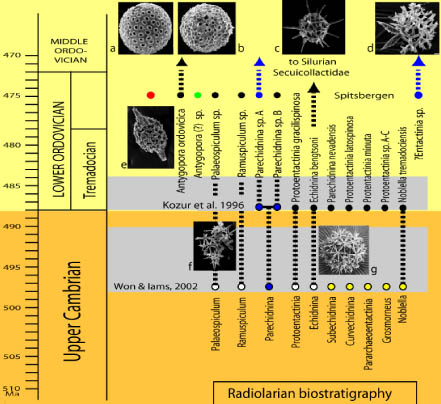 I
am using a high-resolution chrono- and biostratigraphic correlation
approach to get data to trace and specify macro- and microevolutionary
patterns and to attain detailed data sets for stratigraphic and
phylogenetic research on graptolites and radiolarians. Therefore I am involved in a number
of sub-commissions of the ICS. It also includes the preparation of the
Silurian Monograph of the German Sub-commission of Silurian Stratigraphy
(eds. T. Heuse & D. Leonhardt, 2006). Planktic colonial organisms like
the Graptolithina are generally considered as facies independent. Their
distribution pattern is based on ecological factors like water mass
specifities and temperature gradients. Thus, they are prime suspects for
fine-scale stratigraphic correlation on a worldwide scale. Similarly
radiolarians are widely distributed and mostly restricted through
temperature gradients and current patterns in the oceans.
I
am using a high-resolution chrono- and biostratigraphic correlation
approach to get data to trace and specify macro- and microevolutionary
patterns and to attain detailed data sets for stratigraphic and
phylogenetic research on graptolites and radiolarians. Therefore I am involved in a number
of sub-commissions of the ICS. It also includes the preparation of the
Silurian Monograph of the German Sub-commission of Silurian Stratigraphy
(eds. T. Heuse & D. Leonhardt, 2006). Planktic colonial organisms like
the Graptolithina are generally considered as facies independent. Their
distribution pattern is based on ecological factors like water mass
specifities and temperature gradients. Thus, they are prime suspects for
fine-scale stratigraphic correlation on a worldwide scale. Similarly
radiolarians are widely distributed and mostly restricted through
temperature gradients and current patterns in the oceans.
Radiolarian biostratigraphy (after Maletz & Bruton, 2005)
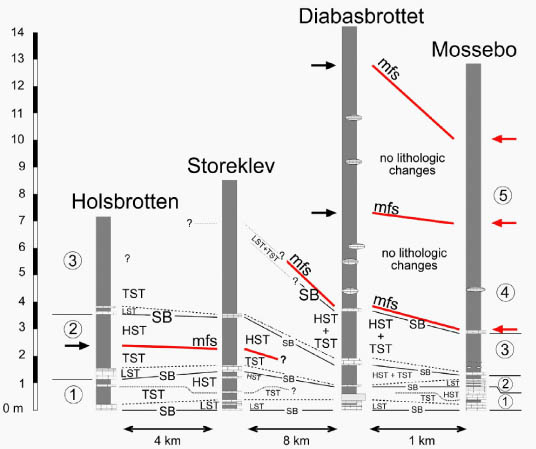 Graptolites
are widely distributed in various sediments and environments. They are
most easily preserved in anoxic environments as their skeletons are made
of organic materials. This fact restricts their distribution and needs to
be taken into consideration when looking at occurrences of graptolites.
Graptolite distribution is highly uneven in most sections and distinct
patterns may be found. The distribution of certain planktic
graptolites in deep water shelf sequences may be used to identify sequence
stratigraphic boundaries (Egenhoff & Maletz 2007) based on the
occurrence of deep water and shallow water forms.
Graptolites
are widely distributed in various sediments and environments. They are
most easily preserved in anoxic environments as their skeletons are made
of organic materials. This fact restricts their distribution and needs to
be taken into consideration when looking at occurrences of graptolites.
Graptolite distribution is highly uneven in most sections and distinct
patterns may be found. The distribution of certain planktic
graptolites in deep water shelf sequences may be used to identify sequence
stratigraphic boundaries (Egenhoff & Maletz 2007) based on the
occurrence of deep water and shallow water forms.
Graptolite bio-sequence stratigraphy at Mt. Hunneberg
(Egenhoff & Maletz, 2007)
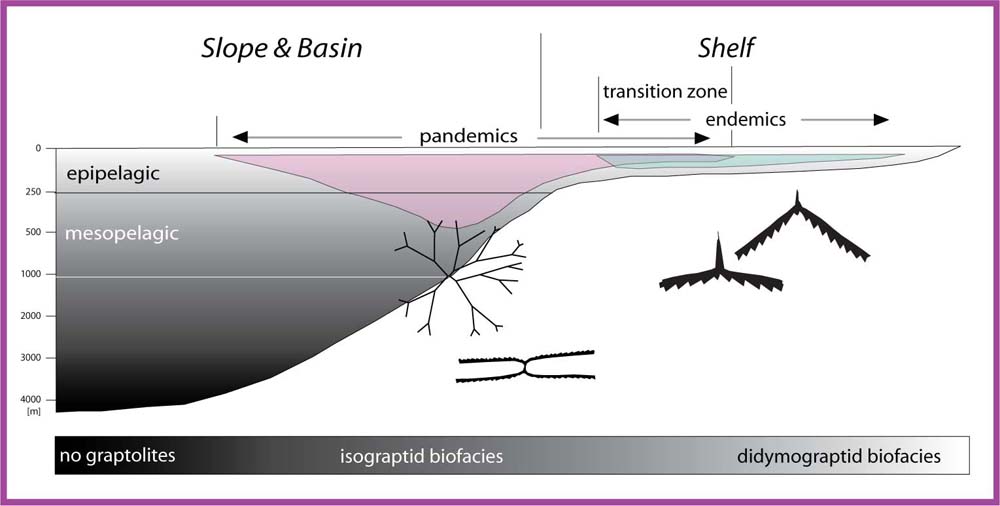 I
am interested in the evolution of the marine plankton and its interactions
in the Paleozoic; interactions between planktic faunas, the environment,
climate and paleogeography to document extinction and origination rates
and how they influence evolutionary patterns. The early evolution of planktic
organisms is still a mystery the exact pathways of their
evolution and the driving forces behind it have not been deciphered so
far.
I
am interested in the evolution of the marine plankton and its interactions
in the Paleozoic; interactions between planktic faunas, the environment,
climate and paleogeography to document extinction and origination rates
and how they influence evolutionary patterns. The early evolution of planktic
organisms is still a mystery the exact pathways of their
evolution and the driving forces behind it have not been deciphered so
far.
Graptolite depth distribution
(Egenhoff & Maletz, 2007)
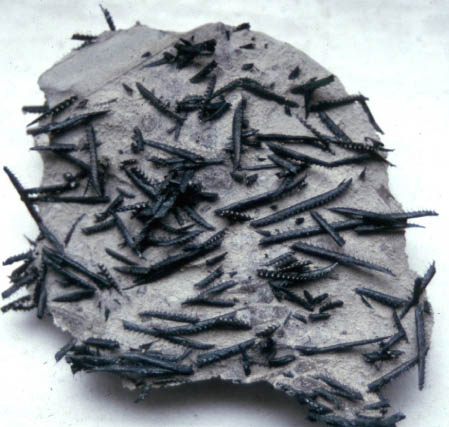 The evolution of animal
coloniality is a complex and astonishing issue with more open-ended questions
than solved ones. Colonial organisms like the extinct Graptolithina
offered a lifestyle unique to the Palaeozoic, but were doomed through
evolutionary restrictions not well understood. They show a distinctly
limited constructional disparity due to their unique skeletal development,
preventing them from attaining a leading role, but permitting a limited
success in the marine ecosystem. I am interested in micro- and macro-evolutionary patterns of these Hemichordata as a unique example of
the evolution of modular colonial organisms in the marine ecosystem.
Phylogenetic interpretations and research on constructional morphology of
the colonies may help to understand the needs of these complex organisms
for their special planktic life style. Spacial and temporal distribution
of faunas might shed light on the factors responsible for origination and
extinction events in the evolutionary history of the faunal groups
involved and are an important tool to paleogeographic interpretations.
The evolution of animal
coloniality is a complex and astonishing issue with more open-ended questions
than solved ones. Colonial organisms like the extinct Graptolithina
offered a lifestyle unique to the Palaeozoic, but were doomed through
evolutionary restrictions not well understood. They show a distinctly
limited constructional disparity due to their unique skeletal development,
preventing them from attaining a leading role, but permitting a limited
success in the marine ecosystem. I am interested in micro- and macro-evolutionary patterns of these Hemichordata as a unique example of
the evolution of modular colonial organisms in the marine ecosystem.
Phylogenetic interpretations and research on constructional morphology of
the colonies may help to understand the needs of these complex organisms
for their special planktic life style. Spacial and temporal distribution
of faunas might shed light on the factors responsible for origination and
extinction events in the evolutionary history of the faunal groups
involved and are an important tool to paleogeographic interpretations.
Isolated
Saetograptus sp. cf. S. leintwardinensis,
Glacial boulder, northern Germany (Maletz, unpublished)
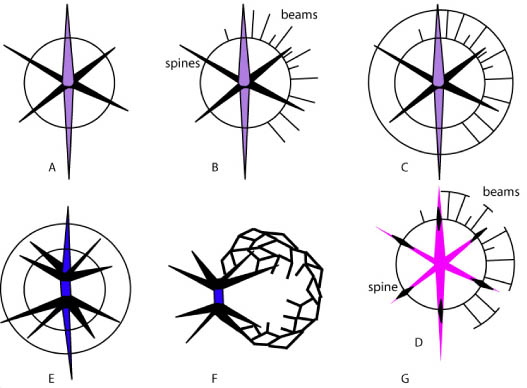 Radiolarians appear first
in the early Paleozoic (probably in the Middle Cambrian), but their occurrence is poorly documented and
their phylogeny and evolution nearly unknown. Serious problems in the
taxonomy of Paleozoic radiolarian faunas still prevent them from being
used successfully for ecological, biogeographical and biostratigraphical
interpretations. Newly discovered rich radiolarian faunas of Ordovician
age may shed light into the early evolution of their skeleton complexity
and to understand the evolutionary lineages leading to modern day
radiolarians, but also to develop them as an important tool for
biostratigraphy in the Paleozoic.
Radiolarians appear first
in the early Paleozoic (probably in the Middle Cambrian), but their occurrence is poorly documented and
their phylogeny and evolution nearly unknown. Serious problems in the
taxonomy of Paleozoic radiolarian faunas still prevent them from being
used successfully for ecological, biogeographical and biostratigraphical
interpretations. Newly discovered rich radiolarian faunas of Ordovician
age may shed light into the early evolution of their skeleton complexity
and to understand the evolutionary lineages leading to modern day
radiolarians, but also to develop them as an important tool for
biostratigraphy in the Paleozoic.
Radiolarian
skeleton development (Maletz & Bruton, 2007)
Current Research Topics
StatoilHydro - Bergen, Norway. Judith L. Hannah (CSU Fort Collins, Colorado/NGU Norway), Sven Egenhoff (CSU Fort Collins, Colorado), Holly J. Stein (CSU Fort Collins, Colorado/NGU Norway), Jörg Maletz (SUNY Buffalo. New York). Collaborative research: Direct Re-Os dating of Ordovician graptolite biozones in Norway and Newfoundland: refining global correlations and Earth Time. - submitted December 2007.
NSF Ear-0745502. Jörg Maletz, Charles E. Mitchell (SUNY Buffalo, New York), H. David Sheets Canisius College, Buffalo, New York). Collaborative research: Quantitative assessment of paleogeography of the Iapetus Ocean based on Late Ordovician graptolite species distributions and abundances. – submitted July 2007. (417,115 US$ for 48 months).
NSF Ear-0744819. Judith L. Hannah (CSU Fort Collins, Colorado), Sven Egenhoff (CSU Fort Collins, Colorado), Holly J. Stein (CSU Fort Collins, Colorado), Jörg Maletz (SUNY Buffalo. New York). Collaborative research: Direct Re-Os dating of Ordovician graptolite biozones in Norway and Newfoundland: refining global correlations and Earth Time. – submitted July 2007. (224,424 US$ for 24 month).
- Graptolite macroevolution: Phylogenetic analysis and testing hypothesis of directional change. – NSF Grant to C. E. Mitchell (Buffalo, N.Y.), D. Goldman (Dayton, Ohio), in connection with R.A. Cooper (Lower Hutt, New Zealand), P. Sadler (Riverside, Calif.), E.D. Brussa (Salta, Argentina).
- Chrono- and biostratigraphy in the Paleozoic (Cambrian – Devonian), integrating sedimentological and paleontological methods to achieve enhanced biostratigraphic reliability for geological interpretations (biostratigraphy, paleogeography, structural geology). For this purpose fieldwork is done in a number of regions:
a) Ordovician-Silurian successions in North and South America (New York State, Quebec, Bolivia, Argentina). Litho- and biostratigraphy, paleogeography, evolutionary studies on graptolites. C.E. Mitchell (UB Buffalo, N.Y), D. Goldman (Dayton, Ohio), R. Suarez-Sorruco (Cochabamba, Bolivia), S.O. Egenhoff (TU Bergakademie Freiberg, Germany).
b) Paleozoic successions of the Scandinavian platform, a unique intermediate to cold-water carbonate platform without modern examples. Dr. S. O. Egenhoff (TU Bergakademie Freiberg, Germany) is responsible for the carbonate sedimentological investigations. Dr. S.S. Stouge (Copenhagen, Denmark), A.T. Nielsen (Copenhagen, Denmark)
c) Paleozoic successions in Central Europe and their integration in plate tectonic models, mainly focussing on pre-Variscan geology. H. Feldrappe (BGR, Berlin), Prof. Dr. G. Katzung (Berlin).
Other projects
Treatise on Invertebrate Paleontology, part V, Graptolithina (eds. C.E. Mitchell, Buffalo, N.Y. & M.J. Melchin, Antigonish, Canada). Responsibility for taxonomy of the Dichograptacea, Glossograptacea, Dendroid orders; Terminology of the Graptolithina.
Revision and updating of the geological aspects (Historical Geology & Time Scale) in the „Brockhaus“-Encyclopaedia for Bibliographisches Institut Gmbh, Gütersloh, Germany, together with Sven O. Egenhoff (TU Bergakademie Freiberg, Germany) and Helga DeWall (Univ. Würzburg, Germany).
Research Projects (planned)
Origin and evolution of pterobranchs in the Early to Middle Cambrian– to be submitted to NSF
Earliest pterobranchs were discovered in the Cambrian Wheeler Shale and the Burgess Shale Formation of North America. Similar organisms are present in the Chengjiang biota of China and in the Middle Cambrian succession of the Czech Republic. Their detailed structure and development may shed light on their early evolution and the question of the origin of coloniality in this group of marine organisms. Earliest pterobranch faunas are rarely described and only few specimens have ever been discovered. However, often misunderstanding and even misinterpretation of colonial pterobranchs as fossil algae has hampered the understanding of this group and its evolutionary patterns.
Ordovician Radiolaria in western Newfoundland – Integrated biostratigraphy of the Cow Head Group – to be submitted to NSF
Radiolaria in the Lower to Middle Ordovician Cow Head and Table Head Groups can provide vital biostratigraphic information for correlation and interpretation of early Paleozoic deepwater successions in which other faunal elements are not present. The Cow Head and Table Head Groups are well known from their fossil content and biostratigraphic data are available from diverse faunal groups, including graptolites, conodonts and chitinozoans. The integration of radiolarian faunas, thus, establishes important ties for a wider application of biostratigraphic time scales for structural geology and even sequence stratigraphic purposes.
Research Projects (finished)
DFG (German Science Foundation) Research Grant DFG-Ma 1269/5-1 (July 1999 to June 2001): Graptolite biodiversity in the early Paleozoic: Interactions of ecological factors with evolution and Extinction events.
DFG Habilitation Grant Ma 1269/4-1 (January 1996 to December 1997) : Terrane analysis of the Lower to Midle Ordovician of eastern Avalonia, Baltica and Laurentia using graptolite faunas and their paleogeographic distributions.
DFG Research Grant Ma 1269/2-1 (April 1993 to March 1995): Investigation of proximal end structure of late Arenig to Llanvirnian diplograptid graptolites and their phylogenetic relationships.
DUGW-Projekt (1992 - 2000): Precambrian to Silurian of the southern Baltic Sea: The Adlergrund G14 drill core. incl. Prof. Dr. G. Katzung, Prof. Dr. I. Hinz-Schallreuter, PD. Dr. R. Schallreuter, Dipl.-Geol. H. Beier (Univ. Greifswald)
NATO Project CRG.900816 (1991-1997) M. Vanguestaine (Liege, Belgium), B.-D. Erdtmann (Berlin, Germany), Jörg Maletz (Berlin), Thomas Servais (Liege). Title: Ordovician acritarch/graptolite stratigraphy, and correlation between Belgium and Germany (TU Berlin/Université de Liège)